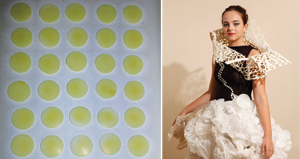
The elegant dress, Manjusaka, designed by Zachery Cheong Zhan at Nanyang Technological University (NTU) was coated with a special mixture developed by Loh Xian Jun at the A*STAR Institute of Materials Research and Engineering (IMRE) that emits a continuously captivating fragrance.
© 2014 Loh Qi Zhi Clifford
Summer days bring thoughts of beach picnics, outdoor barbecues and pool parties. Yet it only takes the buzz of one tiny mosquito to dampen the fun.
But what if your outfit was equipped to release the scent of lemongrass? A quick rub of your hands over the fabric and the pests would be kept at bay by the odor they so despise. This proposal was just one of many wearable technologies caught walking down the runway earlier this year at a showcase organized by A*STAR’s technology transfer arm, ETPL (Exploit Technologies Pte Ltd), during the Startup Asia Singapore 2014 conference.
To realize this bug-repelling design concept, Loh Xian Jun at the A*STAR Institute of Materials Research and Engineering (IMRE) developed a sprayable mixture of a fragrance oil and a polymer that emits its scent at a sustained rate. The process is based on the same microencapsulation technology used to control the release of drugs.
Rather than tackle mosquitoes, the mixture was used at the showcase to enhance the sensory experience of several elegant dresses designed by students at Nanyang Technological University in Singapore, under the guidance of visiting assistant professor Galina Mihaleva. Among the other wearable technologies enriching the fashion collection were luminescent silks, printed electronic materials that switch from opaque to transparent in response to changes in temperature, and sensor beads that darken under extended exposure to ultraviolet light.

Ultraviolet sensor beads (left) produced by Santiranjan Shannigrahi at the IMRE were glued onto a dress (right) designed by visiting assistant professor at NTU, Galina Mihaleva, and showcased at the Next-to-the-Skin event. The naturally yellow beads turn black under ultraviolet light, indicating prolonged and potentially harmful exposure levels.
© 2014 A*STAR Institute of Materials Research and Engineering (left); © 2014 Loh Qi Zhi Clifford (right)
The purpose of the technology showcase, entitled Next-to-the-Skin, was to bridge the gap between research and product development, explains assistant vice president at ETPL, Radiana Soh. “We sought to create a platform for scientists, fashion and industrial designers, and industry professionals on which they could engage and ideate at the early stages of commercializing a technology.”
By introducing the concept of ‘design thinking’ in the early stages of the technology transfer process, ETPL was able to offer A*STAR researchers a new perspective on developing products that address consumer needs while providing innovators with a better understanding of the technologies available to them.
“The process was a game-changing experience for me,” reflects researcher Santiranjan Shannigrahi from the IMRE, who created the ultraviolet-sensitive beads. “I would never have thought that our materials could find a use in such applications.”

The revolutionary cooling fabric, MKool, developed by Shah Kwok Wei at the IMRE was incorporated into the white scarf of the outfit ἀήρ, meaning air in Greek. Designed by Derek Teong Shi Hong, ἀήρ is the visual expression of a life-sustaining breath of cool, pure air.
© 2014 Loh Qi Zhi Clifford
The success of this new way of thinking was apparent in the host of prototypes developed by A*STAR researchers in the month leading up to the final exhibit.
For example, Serene Ng Lay Geok at the A*STAR Data Storage Institute invented SleepPro, a smart sleeping pillow that uses patented software developed by the A*STAR Institute for Infocomm Research to monitor the sleeper’s heart rate, breathing and sleep patterns. The comfortable headrest can be used by elderly or sick patients to alert caregivers of any abnormal behavior.
Another prototype presented at the showcase was MKool, a cooling pad designed by Shah Kwok Wei, a researcher at the IMRE. The pad combines heat-conductive nanofibers and a phase-change material that stores heat by changing its physical state to keep the body’s temperature at a comfortable level. Nanosilver ions, also incorporated into the fabric, confer the pad with antibacterial and odor-killing properties.
Beyond highlighting the potential for technological innovation at A*STAR, Next-to-the-Skin also emphasized the commercial viability of prototypes such as MKool, notes Soh. “We hope to accelerate the process of bringing our products to market by creating an ecosystem for early-stage collaboration through events such as this.”
About ETPL
ETPL (Exploit Technologies Pte Ltd) is the technology transfer arm of A*STAR. Its mission is to support A*STAR in transforming the economy through commercializing R&D. ETPL enhances the research output of A*STAR scientists by translating their inventions into marketable products or processes. Through licensing deals and spin-offs with industry partners, ETPL is a key driver of technology transfer in Singapore. It actively engages industry leaders and players to commercialize A*STAR’s technologies and capabilities, bridging the gap from mind to market. ETPL’s charter is to identify, protect and exploit promising intellectual property created by A*STAR’s research institutes, and apply them to benefit business, industry and economy.




